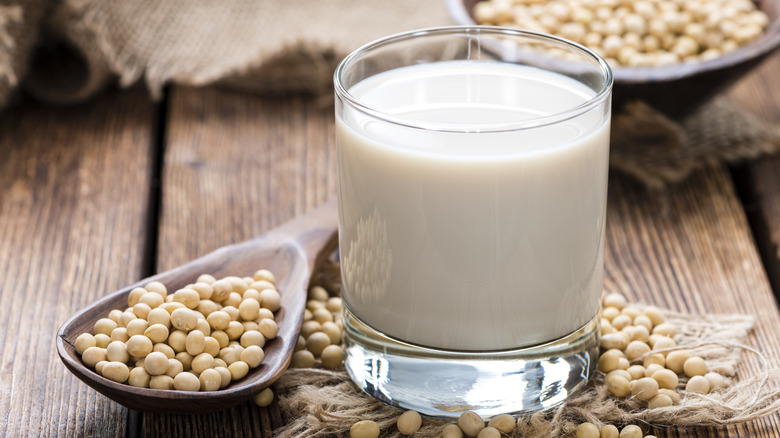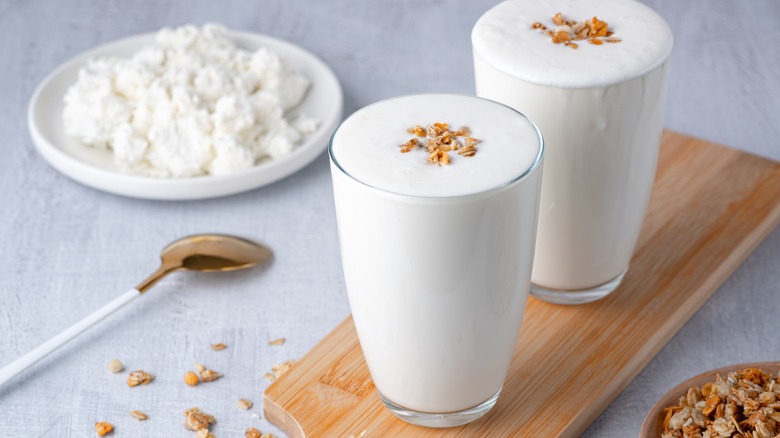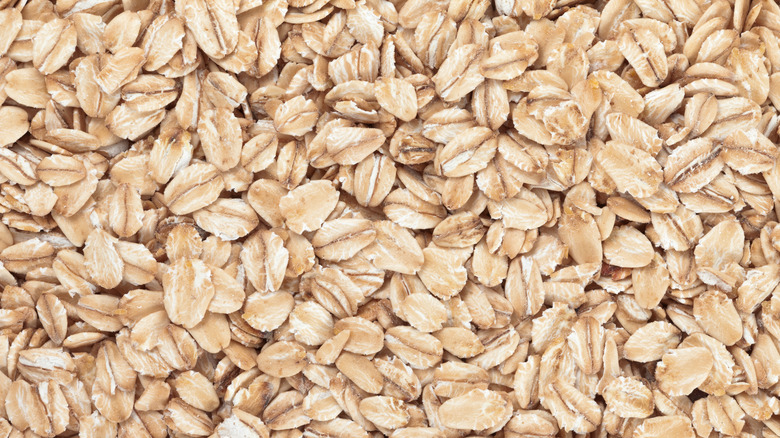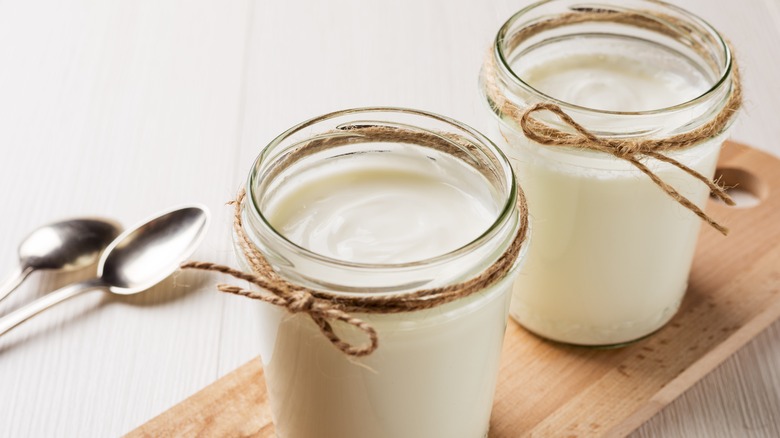Drinks That Have More Protein Than A Glass Of Milk
Chances are you've heard of nutrients, but how about macronutrients? As the MD Anderson Cancer Center explains, protein is a type of macronutrient because we need large quantities of it in our diets. In fact, not getting enough protein can be detrimental to our muscles. With that said, determining how much protein is in a food is not always as simple as you might think.
For example, according to Harvard, "The composition of milk (fat, protein from varying amino acids) may differ depending on the breed and feed of the cows." A 2020 study in the journal Foods notes that there are multiple ways to measure protein. In addition, protein content can vary for a food because of factors like the differences between brands. At the end of the day, this can all feel very confusing, so let's begin by establishing roughly how much protein is in milk.
Per Healthline, whole milk is also called "regular milk." According to the U.S. Department of Agriculture (USDA), one cup of whole milk that has 3.25% milkfat (and vitamin D added to it) has approximately 8 grams of protein. Each of the following foods in this article can exceed that amount of protein (also based on information from the USDA). Of course, before you purchase any of them, make sure to check the information provided by brands for their protein content, as these may vary.
Unsweetened soy milk
As the USDA notes, unsweetened soy milk can have more protein than whole milk. But beyond this, soy contains "all the necessary amino acids," which are the building blocks of protein (via Marketplace Physical Therapy & Wellness Center). This is why soy is considered a source of complete protein (per Harvard). And yes, the terms "complete protein" and "high-quality protein" are sometimes used interchangeably.
While foods like miso and soy sauce are types of fermented soy products, soy milk is an example of an unfermented food made from soy. Additionally, soy and products made from soy are usually high in fiber, minerals like potassium, and other important nutrients. Plus, soy products contain B vitamins. But as with protein content, the exact amount of nutrients can vary from one brand of soy milk to the next.
Interestingly, there has been debate about soy and whether or not it's potentially helpful or harmful. Some, for example, argue that soy lowers the chances of developing breast cancer due to its effects on the body's hormones. Others say that soy consumption can actually raise the risk.
Tofu smoothie
In case you wanted to try something a bit different for your breakfast beverage, you can make yourself a tofu smoothie. Tofu is a type of unfermented soy product; unsurprisingly, it's a good source of protein. According to the USDA's analysis of a particular brand of silken tofu — the kind that you would want to add to a smoothie, since it has a softer consistency than regular tofu — it actually has higher amounts of protein than regular milk.
Soy contains large amounts of a type of plant estrogen known as isoflavones. When consumed, these isoflavones can act like a weaker form of our own estrogen. So, for example, when a woman is experiencing menopause-related hot flashes, it's possible that isoflavones might help reduce these hot flashes. Conversely, there's also concern that eating soy could increase the likelihood of developing serious illnesses, like breast cancer.
While there has been quite a bit of research about soy, an animal study's results might not be a completely accurate indicator as to how soy affects humans. It's worth noting that even human studies might not be strict apples-to-apples comparisons, depending on the type of soy used and the hormonal levels of the participants.
Kefir
According to WebMD, kefir can be made from cow milk, sheep milk, goat milk, or even water. But just because it can contain cow milk doesn't mean this drink is essentially the same as a glass of milk. In fact, kefir and Greek yogurt are similar in the sense that both involve fermentation in the process of their creation; however, kefir isn't as thick as Greek yogurt, making it drinkable.
Since kefir's ingredients can vary, its protein content may vary as well. However, per the USDA's analysis of a particular brand of plain, low-fat kefir, it contains a higher amount of protein than regular milk. In addition, kefir has other potential health benefits. For example, it is loaded with magnesium, which research has found could be beneficial for one's heart, nerves, and muscles. Also, kefir has probiotics, which can help support one's digestive system.
Experts say that adding kefir to one's diet might help with managing weight and cholesterol. But keep in mind that although kefir might be a good addition to one's diet, it can also cause bloating and gas.
Oat smoothie with rolled oats
As the USDA notes, unsweetened plain oat milk can have considerably less protein than regular milk. So, if you want to give your oat milk smoothie a real protein boost, try mixing in some rolled oats.
According to the Food Network, rolled oats get their name because part of the process to create them involves flattening them with rollers. They're also quite common, so you shouldn't have any trouble finding and purchasing them either online or at your local supermarket, sold as either "rolled oats" or "old-fashioned oats". Rolled oats are packed with nutrients, including fiber, iron, B vitamins (such as niacin, riboflavin, and thiamine), and of course, protein.
Per the USDA, 100 grams of rolled oats — which is less than half a cup — can have more than 13 grams of protein. In other words, it doesn't take a great deal of these oats to considerably up the protein content of anything you add them to. Feel free to add anywhere between a quarter and a half cup of oats to your smoothies; you may even want to experiment with larger amounts.
Goat milk
While cows are typically associated with milk, WebMD notes that goat milk is consumed by almost three-quarters of the world. Interestingly, goat milk is not only creamier than cow milk, but is also a good source of protein.
As the USDA notes, fluid goat milk with added vitamin D has more protein than regular milk. Per WebMD, there are areas of the world that rely on goat milk as a major protein source. In addition, findings indicate that our bodies might have an easier time breaking down the protein found in goat milk, as opposed to the kind from cows. Plus, there is evidence that drinking goat milk might help with cholesterol management.
In spite of its potential benefits, goat milk (when compared to some other milks) has larger amounts of sugar, fat, and calories. And even though its protein is more digestible than the protein in cow milk, it also has lactose, making it a probable problematic choice for someone with lactose intolerance. And in case you're thinking of trying raw goat milk (aka goat milk that hasn't been pasteurized): not only does this come with a range of potential health risks, but selling raw milk is also illegal in different areas of the U.S. (although there are certain states that allow the sale of raw goat milk, specifically), via WebMD.
Greek yogurt smoothie
If you browse all the Greek yogurt options at your local supermarket, you'll find that they're made from a wide variety of ingredients, including whole milk (via WebMD). However, due to its consistency, you're unlikely to mistake Greek yogurt for a glass of regular milk. It's improbable for you to mix it up with regular yogurt, either, since it goes through an extra straining process, making it both thicker and creamier.
As with the other foods on this list, the protein content of Greek yogurt can vary by brand. But as the USDA notes, plain Greek yogurt made from whole milk can be considerably higher in protein than regular milk. This protein content makes Greek yogurt a potentially good addition to a weight management meal plan, since it can keep you satiated for a longer period of time. In addition, Greek yogurt contains minerals like potassium and vitamins like B12, and also serves as a good source of probiotics. With that said, it's important to note the fat content of a specific brand's Greek yogurt before you decide to purchase it.
If you're looking to whip up a beverage that contains Greek yogurt, this healthy peach smoothie recipe uses half a cup. That might not sound like much, but as the USDA states, even a little less than half a cup of plain, whole milk Greek yogurt can have more protein than a full cup of whole milk. Additionally, this recipe also calls for almond milk, which also contains some protein.
Sheep milk
According to the book "Non-Bovine Milk and Milk Products," if you compare the milk from cows, goats, and sheep, the sheep milk would have more protein. The USDA also notes that a cup of sheep milk in fluid form has around 14 grams of protein.
Beyond its protein content, a study from 2019 done by experts at the University of Auckland's Liggins Institute and the Crown Research Institute AgResearch found that individuals who have difficulty digesting cow milk might have an easier time with sheep milk. The study involved 30 women who were given either cow milk or New Zealand sheep milk. "We have, for the first time, confirmed that the protein in sheep milk is more readily digested compared to cow milk," study co-lead Dr. Amber Milan explained. "Sheep milk delivered more of the branched-chain amino acids (BCAAs) leucine, valine and isoleucine than cow milk."
You'll probably have an easier time finding products like sheep milk cheese than liquid sheep milk. With that said, kefir can be made from sheep milk. If you want to try liquid sheep milk, there are farms that sell it online. But it isn't legal to sell raw (unpasteurized) sheep milk everywhere in the U.S., and there are health concerns about consuming it (per WebMD). Finally, keep in mind that liquid sheep milk is higher in fat than regular cow milk.








